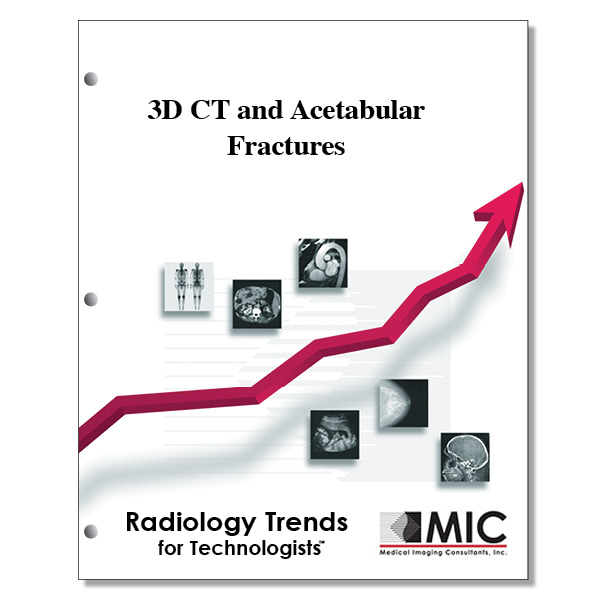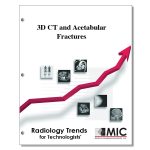

3D CT and Acetabular Fractures
A detailed analysis of acetabular imaging focusing on classifying fractures using 3D multidetector CT images.
Course ID: Q00468 Category: Radiology Trends for Technologists Modalities: CT, Radiography3.0 |
Satisfaction Guarantee |
$34.00
- Targeted CE
- Outline
- Objectives
Targeted CE per ARRT’s Discipline, Category, and Subcategory classification:
[Note: Discipline-specific Targeted CE credits may be less than the total Category A credits approved for this course.]
Computed Tomography: 2.00
Procedures: 2.00
Head, Spine, and Musculoskeletal: 2.00
Outline
- Introduction
- Development of the Acetabulum
- Anatomy of the Acetabulum
- Patients with Acetabular Fracture
- Systems of Acetabular Fracture Classification
- The Judet and Letournel Classification of Acetabular Fractures
- Posterior Wall
- Posterior Column
- Anterior Column
- Anterior Wall
- Transverse
- transverse with Posterior Wall
- T-shaped
- Associated Both-Column
- Anterior Column or Wall with Posterior Hemitransverse
- Posterior Column with Posterior Wall
- OTA/OA Classification of Acetabular Fractures
- Harris Classification of Acetabular Fractures
- Imaging Acetabular Fractures
- How to Practically Classify an Acetabular Fracture
- Reporting and Communicating Acetabular Fractures
- Treatment Considerations
- Operative Acetabular Repair
- Complications Associated with Acetabular Fractures
- Conclusion
Objectives
Upon completion of this course, students will:
- describe the main causes of acetabular fractures
- know the ramifications if an acetabular fracture is not accurately classified or diagnosed
- understand the gestational developments of the hip joint and acetabulum
- know how the pelvic, hip, and acetabular anatomy correlate and the names of the various bones
- describe the key topographic anatomical landmarks of the pelvis
- know the surrounding anatomy of the acetabulum such as key ligaments, fossa, and the sciatic buttress
- be familiar with the frequency of acetabular fractures in multiple trauma settings
- know which age group is more susceptible to acetabular fractures
- understand which factors play a role in defining the type of acetabular fracture
- understand the Judet and Letournel system of acetabular fracture classification
- understand the Orthopedic Trauma Association (OTA)/AO (Association for the Study of Internal Fixation) system of acetabular fracture classification
- name the acetabular fracture classifications in the Judet and Letrournel system versus the OTA/AO
- understand how the Harris system of classification of acetabular fractures developed during the advent of CT
- name four lines that are fundamental to types of fractures in the Judet and Letournel classification system and can be viewed on a AP radiograph of the pelvis
- know which acetabular fractures of the pelvis make up the majority of all fractures in the Judet and Letorurnel classification system
- distinguish some of the limitations of the Judet and Letournel classification system of acetabular fractures
- know the range of thickness of CT slices when performing a scan for pelvic trauma when the clinician is looking to rule out an acetabular fracture
- understand what mechanism, anatomical involvement and how a posterior wall fracture of the acetabulum is viewed on an axial CT scan
- understand what anatomical regions are involved, the stability and how a posterior column fracture of the acetabulum is viewed on an axial CT scan
- understand the anatomical regions involved if an associated hip dislocation is present and how an anterior column fracture of the acetabulum is viewed on an axial CT scan
- describe how the Letournel classification system differentiates anterior wall fractures of the acetabulum from anterior column fractures
- know which acetabular fracture is the least common of all fractures
- know what type of fragments the acetabulum is divided into with a transverse fracture
- name all three categories of transverse acetabular fractures.
- describe what a transverse with posterior wall fracture T-shaped variant is
- understand how both column fractures of the acetabulum are unique
- know what the radiographic “spur sign” is and which radiographic projection visualizes it
- know what the anterior component of anterior with posterior hemitransverse acetabular fracture is and the patient age group it is common in
- describe what a posterior column with posterior wall acetabular fracture is and how the posterior wall fragments may be comminuted and/or impacted
- understand that in the Harris acetabular fracture classification system, anterior and posterior lips of the acetabulum are defined as walls, and the more medial portions of the acetabulum, including the quadrilateral plate, are considered the columns
- understand what radiographic exposure, positioning and technical factors are key to producing both stationary and mobile pelvic radiographs
- describe the strengths and weakness of radiography versus CT in the evaluation of acetabular fractures
- understand the value of Judet radiographic projections and how they are performed
- know the key CT techniques for imaging of the pelvis; including panscanning, 3D surface rendering and thin slice axial CT
- understand the estimated radiation dose of a five view pelvic conventional radiographic study versus CT
- understand the Brandser question-based algorithm to systematically classify acetabular fractures into a specific Judet and Letournel fracture category
- understand how acetabular column and wall fractures are oriented at the level of the acetabular roof on CT images
- describe the fracture modifiers in the Judet and Letournel classification system of acetabular fractures
- name treatment options for acetabular fractures and long term outcomes of each
- name some of the factors derived from radiography and CT that pertain to whether an acetabular fracture requires surgical intervention
